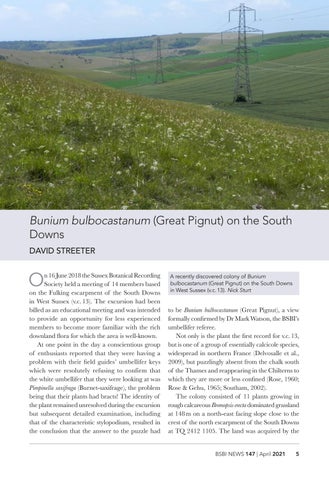Bunium bulbocastanum (Great Pignut) on the South Downs DAVID STREETER
O
n 16 June 2018 the Sussex Botanical Recording Society held a meeting of 14 members based on the Fulking escarpment of the South Downs in West Sussex (v.c. 13). The excursion had been billed as an educational meeting and was intended to provide an opportunity for less experienced members to become more familiar with the rich downland flora for which the area is well-known. At one point in the day a conscientious group of enthusiasts reported that they were having a problem with their field guides’ umbellifer keys which were resolutely refusing to confirm that the white umbellifer that they were looking at was Pimpinella saxifraga (Burnet-saxifrage), the problem being that their plants had bracts! The identity of the plant remained unresolved during the excursion but subsequent detailed examination, including that of the characteristic stylopodium, resulted in the conclusion that the answer to the puzzle had
A recently discovered colony of Bunium bulbocastanum (Great Pignut) on the South Downs in West Sussex (v.c. 13). Nick Sturt
to be Bunium bulbocastanum (Great Pignut), a view formally confirmed by Dr Mark Watson, the BSBI’s umbellifer referee. Not only is the plant the first record for v.c. 13, but is one of a group of essentially calcicole species, widespread in northern France (Delvosalle et al., 2009), but puzzlingly absent from the chalk south of the Thames and reappearing in the Chilterns to which they are more or less confined (Rose, 1960; Rose & Gehu, 1965; Southam, 2002). The colony consisted of 11 plants growing in rough calcareous Bromopsis erecta dominated grassland at 148 m on a north-east facing slope close to the crest of the north escarpment of the South Downs at TQ 2412 1105. The land was acquired by the BSBI NEWS 147 | April 2021
5
















